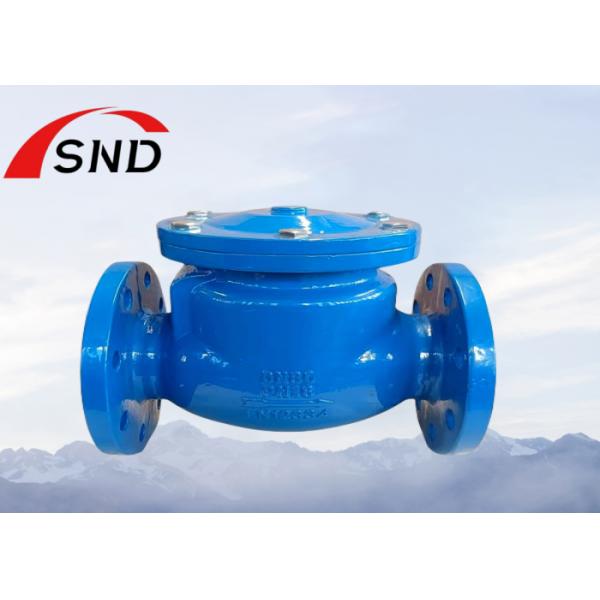Product Description
Ductile Iron Swing Check Valve Used To Prevent Medium Backflow
This is a swing check valve, a type of check valve. It plays a
"one-way passage" role in the fluid pipeline to prevent the medium
from flowing back. The following is a detailed analysis from the
structure, principle, and application:
Core Structure & Working Principle
Valve Body (Blue Body): Material: ductile iron (surface anti-corrosion spray),
pressure-resistant, corrosion-resistant, suitable for water, oil,
light gas and other media. The flanges at both ends connect the
pipeline to facilitate splicing with the pipeline network (such as
municipal water supply, factory circulating water system).
Casting Information: Usually marked with nominal diameter (DN) and pressure rating
(PN), such as DN100, PN16 (adaptive pipeline size, pressure
resistance).
Valve Disc (The "Door Plate" Hidden Inside): The core of the check valve: There is a "valve disc" (similar to
the structure of a door) that can rotate around the axis in the
valve body. When the medium flows forward (along the direction of
the pipeline arrow), the thrust pushes the valve disc open (like a
door is pushed open), and the pipeline is open; when the medium
flows back, the valve disc automatically rotates to close the valve
port by its own gravity + reverse medium pressure to prevent
backflow.
Flow Direction Restriction: During installation, the forward flow direction of the pipeline
medium (arrow direction) must be strictly aligned. If it is
installed in reverse, the check function will be completely lost,
and the valve may even be damaged by backflow impact.
Application Scenarios & Value
Water Pump Outlet: For example, the secondary water supply pump of the community and
the circulating pump of the factory cooling tower, the valve disc
closes quickly when the pump is stopped to prevent water from
backflowing and impacting the pump impeller (avoiding the "water
hammer effect"-backflowing water may damage the impeller and crack
the pipeline).
Large Pipeline Trunks: Urban water pipelines, long-distance oil pipelines, due to the
large pipe diameter and strong medium flow inertia, the "large
valve disc" of the swing check valve is more suitable - the sealing
area is large when closed, the check effect is good, and the valve
disc rotates flexibly and is not easy to get stuck (more suitable
for large flow scenarios than small-diameter check valves).
Steam System: In some steam pipelines (such as thermal power plants and printing
and dyeing plants), when steam condensate flows back, the swing
check valve can prevent steam from flowing back and allow
condensate to be discharged (but the steam system often uses "drain
check valves", which depends on the specific design).
Comparison With Other Check Valves
✔️ Suitable for Large Diameters: The structure of the valve disc rotating to open has small flow
resistance (the medium can pass quickly), suitable for large
pipelines above DN50 (for example, the valve in your picture is
visually DN100-DN200 level).
✔️ Reliable Sealing: When the valve disc is closed, the area of contact with the valve
seat is large. The greater the reverse pressure, the tighter the
seal (but after long-term use, the valve disc may leak due to wear
and tear, and regular maintenance is required).
❌ Not Suitable for Small Flow: For small pipes (below DN50), the swing type may cause the valve
disc gravity to cause untimely closure. Generally, it is more
accurate to choose a "lift check valve".
Simply put, this is the "one-way door god" of large pipelines. It
automatically responds to "forward flow and reverse blockage" by
rotating the valve disc, protecting the pipeline network from
bursting due to backflow and equipment from damage due to water
hammer. It is a must-have valve for municipal and industrial
large-flow pipelines.


